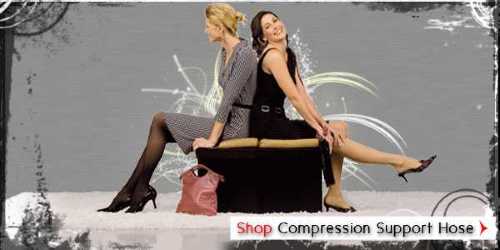Compression Support Hose
Compression support hose, also known as compression stockings or compression socks, are specialized garments designed to improve blood circulation in the legs and feet. These garments are made of a stretchy, tight-fitting material that exerts pressure on the legs, ankles, and feet, thereby compressing the veins and improving the flow of blood back to the heart. Compression support hose are available in various sizes, colors, and compression levels, and are worn by people of all ages and lifestyles.
Click here to find your favorite support hose for compression.
Compression support hose are commonly prescribed by doctors to patients with various medical conditions, such as varicose veins, deep vein thrombosis (DVT), lymphedema, and chronic venous insufficiency (CVI). Varicose veins are enlarged, twisted veins that often appear on the legs and feet, and can cause discomfort, pain, and swelling. DVT is a blood clot that forms in a deep vein, usually in the legs, and can lead to serious health problems if not treated promptly. Lymphedema is a condition where the lymphatic system is impaired, causing fluid buildup and swelling in the legs and feet. CVI is a condition where the valves in the veins of the legs are weakened or damaged, causing blood to pool in the lower legs and feet.
Compression support hose work by exerting pressure on the legs and feet, which helps to push blood back up to the heart. The pressure created by the compression stockings compresses the veins and lymphatic vessels, which helps to prevent blood and fluid from pooling in the legs and feet. This improves circulation, reduces swelling, and relieves discomfort and pain.
Compression support hose are available in various compression levels of pressure, which are measured in millimeters of mercury (mmHg). The higher the compression level, the greater the pressure exerted by the compression stockings. Compression levels range from 8-15 mmHg (mild compression) to 30-40 mmHg (extra firm compression). Mild compression stockings are often used by people who stand or sit for long periods of time, such as office workers, travelers, and pregnant women. Moderate compression stockings are used to treat mild to moderate varicose veins, spider veins, and mild swelling. Firm compression stockings are used to treat moderate to severe varicose veins, edema, and leg ulcers. Extra firm compression stockings are used for severe lymphedema, severe venous insufficiency, and post-thrombotic syndrome.
Compression support hose are available in different lengths and styles, including knee-high, thigh-high, and waist-high stockings. Knee-high stockings are the most common type of compression stockings, as they are easy to put on and take off and can be worn with most types of clothing. Thigh-high stockings provide compression from the toes to the thigh, and are often recommended for people with more severe vein problems. Waist-high stockings provide compression from the toes to the waist, and are often recommended for people with severe edema or lymphedema.
Compression support hose are made of various materials, including nylon, spandex, and cotton. Nylon and spandex are the most common materials used, as they are stretchy and provide the necessary compression. Cotton is sometimes used for people with sensitive skin, as it is a more breathable material.
Compression support hose are available in different colors and patterns, and can be purchased at most pharmacies, medical supply stores, and online retailers. Some compression stockings come with zippers or Velcro fasteners to make them easier to put on and take off. Others are designed to look like regular stockings or socks, so that they can be worn with normal clothing without being noticeable.
Wearing compression support hose is generally safe, but it is important to consult with a healthcare provider before using them, especially if you have any medical conditions or are pregnant. Your healthcare provider can help you choose the appropriate compression level, length, and style of compression stockings, as well as provide instructions on how to properly put them on and take them off.
It is also important to properly care for your compression support hose to ensure their effectiveness and longevity. Compression stockings should be washed regularly in cool or lukewarm water with mild detergent, and should be air-dried. It is important to avoid using fabric softeners or bleach, as they can damage the elasticity of the stockings. It is also recommended to replace compression stockings every 3-6 months, or as recommended by your healthcare provider.
In addition to medical conditions, compression support hose can also be beneficial for athletes and people with active lifestyles. Compression stockings can help to improve blood flow, reduce muscle fatigue, and prevent injury during physical activity. Some athletes wear compression stockings during competitions or long training sessions to help improve performance and aid in recovery.
Compression support hose can also be helpful for people who travel frequently, particularly on long flights. Sitting for extended periods of time on a plane can lead to poor circulation and swelling in the legs and feet, known as "economy class syndrome." Wearing compression stockings during a flight can help to prevent this, as well as reduce the risk of blood clots forming in the legs.
In summary, compression support hose are specialized garments that are designed to improve blood circulation in the legs and feet. They are commonly prescribed by doctors for various medical conditions, and are available in various compression levels, lengths, and styles. Compression stockings are also beneficial for athletes and people with active lifestyles, as well as frequent travelers. It is important to properly care for compression support hose to ensure their effectiveness and longevity. If you have any medical conditions or are pregnant, it is important to consult with a healthcare provider before using compression stockings.
